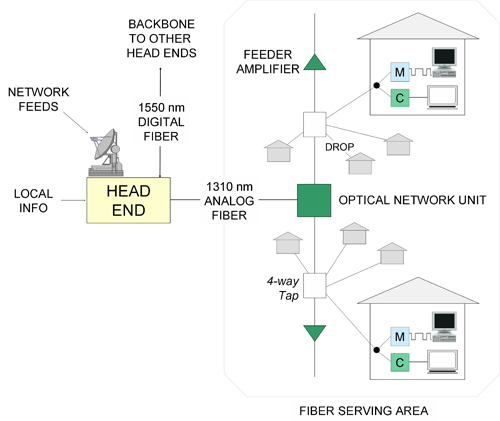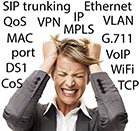Note: This is an archived article that appeared in the Teracom newsletter November 2001, and this article has not been updated to reflect technology developments since then.
Please be assured that our training courses have been updated since the time of this article!
Cable ModemsTelephone lines are not the only kind of "analog circuit". Techniques similar to voiceband analogs of sound pressure waves are used to communicate analogs of video pictures on Cable TV systems.
Cable TV Network Architecture
A basic Cable TV network consists of a Head End, fiber transmission systems, Optical Network Units, coaxial copper cabling, amplifiers, splitters, taps and drop lines into customers' homes where a converter and television set are located.

The bandwidth (frequency range) available is much wider than a voiceband channel - at least 450 MHz and as much as 900 MHz due to the characteristics of the coax drop wires compared to twisted pair. Such systems are often called wideband or broadband analog.
Frequency Division Multiplexing
The Head End gathers video signals from satellites, terrestrial antennas and local content sources like DVD players, and uses Frequency Division Multiplexing (FDM) to put them all together: dividing the available frequency band into a number of smaller 6 MHz-wide frequency bands called channels, and placing a television picture in each channel using a type of modulation called Vestigial Side Band Amplitude Modulation (VSB-AM).
Using this technique, we pick a single pure frequency, called a carrier frequency, for each channel and change or modulate its volume up and down continuously in proportion to the television signal intensity. This is an analog technique.

As illustrated in Figure 97, this entire group of signals is transmitted on most modern systems via fiber-optic cabling into residential areas. The fibers terminate on Optical Network Units, where the signals are transferred to copper coaxial ("coax") feeder cables, used to deliver the signal to 4-way taps. Since this is an analog technique, amplifiers are used to boost up the signal as it attenuates with distance over the cable. The attenuation is worse on coax than twisted pair: amplifiers are typically required every 660 feet on the coax.
A copper coaxial drop wire comes from the tap into the residence. The television tuner or converter picks the desired signal out of the entire lot, and shifts it back down to the "natural" frequency range 0 - 4 MHz so that it can be displayed on the screen of the television. This "natural" frequency range, the one that starts at 0 Hz is called the baseband, or sometimes Channel 1.
Modems on Cable TV: Challenges
Once a cable TV system is set up, there is no reason why we have to use it just for analog video signals. We could put modems on the system that employ some of the bandwidth to transmit data instead.
To enable two-way data communications using modems on this system, there are several problems to be addressed:
One issue is the fact that cable TV employs multi-drop techniques for the distribution: everyone on your street is sharing the same access circuit - so how do we have different users running modems at the same time?
Another problem is that these systems were originally designed for one-way communications, so all of the amplifiers were originally one-way, and only amplifying that frequency range employed for the television pictures.
Two-way Amplification
We can solve the amplification problem by allocating some of the frequency band available on the cable for modem signals in each direction, and having crews install additional amplifiers for those frequencies on the wires running down your street.

Sharing the Access Circuit
The question of multiple modems on the same access circuit is more difficult.
One strategy would be to use channels like those defined for video, but put modems on them instead. Each user who subscribed to the cable modem service would be assigned a frequency channel for their modem, with a corresponding modem at the Head End or ONU. This is a very static, limiting allocation of capacity - and we would run out of capacity in short order. What happens if your neighbor does not sign up for the service? Or has their computer turned off? You still can only use your small frequency band.
The strategy that we ended up employing was to allocate a large band above the video for downloading into the residence, and another band below the video for a return channel. This is called a high-low split strategy and makes amplifier deployment easier.
Cable modems today move 30 Mb/s; and typically have 10 Mb/s Ethernet connections from the modem to the computer, which limits the maximum throughput to 10 Mb/s.
However, since the users' modems all employ the same frequency band, they can't all operate at the same time… so the users end up time-sharing the modem band via time slots.
The service provider equipment provides the time reference and controls the allowed usage for each time slot. Time slots may be granted for transmissions by particular modems or for contention by all modems. Collisions can occur and retries are used. This is the same capacity-sharing strategy described for Ethernet in Section 14.2.4.
The problems start when 50 people sign up, and most of them are teenagers running "file swapping" software like Kazaa or e-mule, and these teenagers' computers are continuously contending for the use of the cable modem band to pass on search requests to others running the same program.
Which is Faster, Cable Modem or DSL?
That depends. Since on a cable system, we are all sharing the access, each user's throughput will vary depending on how many neighbors sign up, what they are doing, and by time of day. Contrast this to DSL service, where everyone has their own access line to the DSLAM equipment, and so the access line speed is constant.
Anecdotally, we are finding that cable modem service is blindingly fast at first, but some users are reporting noticeable slowdowns during peak periods. DSL is slower to start with, but no sharing is involved and it's getting faster.
For more information: Teracom reference textbook: Teracom 101


